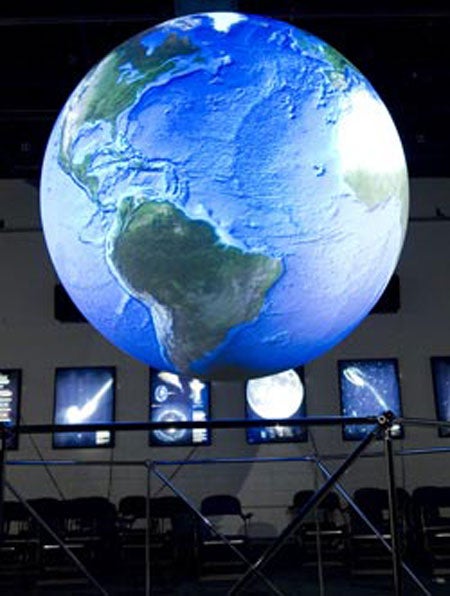This winter the television production team at NASA’s Goddard Space Flight Center in Greenbelt, Maryland, shrank the Moon down to a 6-foot globe and put it on display in the Goddard visitor center. The team made a new, fully spherical short film called “Return to the Moon.” Designed expressly for the Science On a Sphere (SOS) platform, it opens in science museums and elsewhere around the country February 27, 2009.
“Return to the Moon” takes imagery and data sets from the Apollo, Clementine, and other missions and projects them on a 6-foot sphere. The results give the startling impression of the Moon hanging magically in the center of darkened theaters. During the 5-minute film, viewers will witness NASA’s legacy of lunar exploration and come to understand the rationale for the agency’s ambitious plans to return to the Moon, beginning with a robotic mission called the Lunar Reconnaissance Orbiter (LRO).
Both LRO and the Lunar Crater Observation and Sensing Satellite (LCROSS) mission are featured in the new project. The LRO spacecraft will provide scientists with detailed maps of the lunar surface and enhance understanding of the Moon’s topography, lighting conditions, mineralogical composition, and natural resources. LRO will spend at least 1 year in low polar orbit around the Moon, collecting detailed information about the lunar environment and providing key data sets to enable a human return to the Moon. Goddard Space Flight Center manages the lunar orbiter. LCROSS, managed by NASA’s Ames Research Center at Moffett Field, California, will impact the lunar surface in its search for water ice. The LRO/LCROSS mission is scheduled to launch spring 2009.
“Spherical filmmaking brings the Moon and planetary science down to Earth,” said Michael Starobin of Goddard television, producer for “Return to the Moon.” “The subject is often difficult to relate to because the scale is so large or out of context with people’s lives. However, when you project it on a sphere, people suddenly understand the size of regional events while also comprehending the global connections of the science being introduced. Pure data falls flat, but spherical films make planets approachable.”
According to Starobin, there are many ways to project data onto a sphere. The technique he and his colleagues use take massive images – many times larger than HDTV pictures – and slice them into four sections. Each section is sent to one of four projectors arranged around the spherical movie screen. A central computer coordinates with dedicated computers at each projector to blend the sections into a seamless image that wraps completely around the sphere.
“Goddard’s Scientific Visualization Studio takes enormous, highly-technical data sets from various NASA missions and turns them into stunning imagery, while the Goddard television team takes complex scientific subjects and translates them into succinct, compelling features,” said Starobin. Just as NASA prides itself at pushing back the boundaries of exploration, we take pride in inventing new ways to communicate the results of that exploration.”
To see how Science On a Sphere works, click here and scroll to bottom of page.










